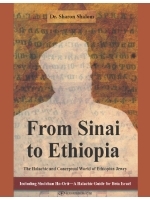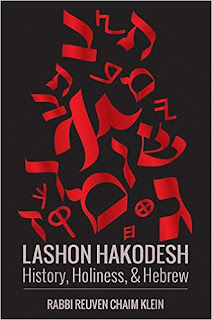From Sinai to Ethiopia

From Sinai To Ethiopia
Rabbi Dr. Sharon Shalom
Gefen / 300 pages
Sharon Shalom’s
book, From Sinai to Ethiopia, is a fascinating and unprecedented look into the
halachic challenges facing Ethiopian Jews as they continue to struggle for
integration into Israel's social and religious society.
Sharon is a musmach
of Yeshivat Har Etzion, received a Ph.D. from Bar Ilan university, and leads a congregation
in Kiryat Gat where he lives. He is one of the gentlest and patient people I
have ever met (well, spoken to on the phone and emailed…we hope to meet face to
face soon!) who is working with all his heart toward helping Ethiopian Jews
find their places within normative Judaism. The author’s intention is to support the
spiritual authenticity and respect for Ethiopian Jewish customs and he works
valiantly in an attempt to do so. Pluralism, acceptance, tolerance and mutual respect
are the dominate themes of every page. It is the first book that I have ever
seen with both rabbinic and kahenic haskamot!
The first part of
the book is a jaw dropping window into the history and spiritual life of
Ethiopian Jews which opens with the author’s personal journey to the land of
Israel. Sharon argues that Ethiopian practices, even those that contradict
normative halacha, are just as legitimate as any other halachic system. We are
introduced to the relationship and influence from the Ethiopian church,
Ethiopian languages, religious tradition, and a timeline of the major
events in the communal life of Ethiopian Jewry.
Although I don’t mean to disappoint Sharon, after reading this section I am convinced that Ethiopian halacha will never be accepted in the halachic community, and indeed there is no room for it. I say this based on the fact that Ethiopian halacha rejects Talmudic authority making it Karaitic in nature. While I am open to alternative halachic systems (for example, complete reliance on the Rambam as per the Yemenite tradition), there is no room for a halachic system that rejects Talmudic authority. So too, and perhaps even more significantly so, is that Ethiopian halacha gives equal weight to all texts, meaning, that the Torah is no more authoritative than any other Deuterocanonical or Apocryphal work!
Although I don’t mean to disappoint Sharon, after reading this section I am convinced that Ethiopian halacha will never be accepted in the halachic community, and indeed there is no room for it. I say this based on the fact that Ethiopian halacha rejects Talmudic authority making it Karaitic in nature. While I am open to alternative halachic systems (for example, complete reliance on the Rambam as per the Yemenite tradition), there is no room for a halachic system that rejects Talmudic authority. So too, and perhaps even more significantly so, is that Ethiopian halacha gives equal weight to all texts, meaning, that the Torah is no more authoritative than any other Deuterocanonical or Apocryphal work!
The second half of
the book is a “Kitzur Shulchan Aruch” that discusses scores
of halachic issues from waking up in the morning to Shabbat, holidays, and family life. With
each of these issues, Sharon first cites the “Ethiopian Halacha” on the matter,
then the “Talmudic Halacha”, and finally, how he recommends Ethiopian Jews in
Israel should conduct themselves in order to better integrate into Israeli society. In almost
all matters, Sharon supports and endorses the Ethiopian halacha, but he often
recommends change, and sometimes abandonment of certain practices, to varying
degrees.
I will share some
examples of Ethiopian halacha and Sharon’s approach to its adaptation. In Ethiopian
halacha, halacha takes priority over even saving a life. Sharon rules that this
halacha must be abandoned in favor of the Talmudic halacha that saving a life
takes precedence over the performance of commandments. Additionally, there is an
Ethiopian halacha that requires one to bring money to the synagogue on Shabbat in
order to offer a donation. In this instance, Sharon supports the continued
practice of this custom even in Israel. So too, the use of umbrellas on Shabbat is
permissible in Ethiopian halacha, and Sharon allows Ethiopians in Israel to
continue this practice on condition that the umbrella is opened before Shabbat
(no mention on the need for an Eruv, either in Ethiopia or in Israel, is
mentioned regarding these last two examples). Finally, when Shabbat and Yom
Kippur coincide, Ethiopian practice is to recite Kiddush and eat a small amount
of food Friday night in order to comply with the Ethiopian halacha (based on the
Book of Jubilees) that fasting on Shabbat is always forbidden without exception.
They then fast for the remainder of Shabbat/Yom Kippur. Needless to say, there is an entire education awaiting readers.
I found this section to be somewhat frustrating as I could not pinpoint a common denominator for Sharon’s
rulings as to when he encourages or permits Ethiopians to continue their
halachic practice and when he tells them to abandon it. There seems to be an inconsistency
in how Ethiopian halacha in Israel is decided. It appears to me that his rulings
are all subjective in nature, and are not based on any guiding principle or
textual authority, it's all simply what he personally feels is the right thing to do. You can judge for yourself. Sharon also differentiates
between what first generation Ethiopian immigrants should do, and what the
second, more Israeli, generation should do. I am very uncomfortable with this. A halachic system of any kind must be consistent and universal.
The question of
whether or not Ethiopian Jews are truly Jewish is not something I really would
like to get into in this review. But to summarize, Rav Ovadia Yosef held that they
are Jewish, while Rav Moshe Feinstein, Rav Eliezer Waldenberg, and Rav Yitzchak
Herzog where not so sure. Indeed, Sharon himself cites seven theories as to the
possible origins of the Ethiopian Jews, four of which puts their purity of
lineage into serious doubt. There is little of more importance in the halachic world today than clarity and purity of lineage.
As such, I see no flexibility in requiring Ethiopian olim to undergo giyur
l’chumra.
From Sinai to
Ethiopia is an extremely valuable work, and an urgent addition to any library
of halacha and minhag. The book is amazing. There is nothing like it and I expect
to refer to it frequently. I congratulate Sharon on a lifetime of achievement
that has only just begun and wish him every blessing and success in spreading Talmudic
Halacha to our brothers and sisters from Ethiopia who have made Israel their
new home. The job isn’t easy but the duty is sacred. Itbarech Egziabher
Amlake Israel amen.

